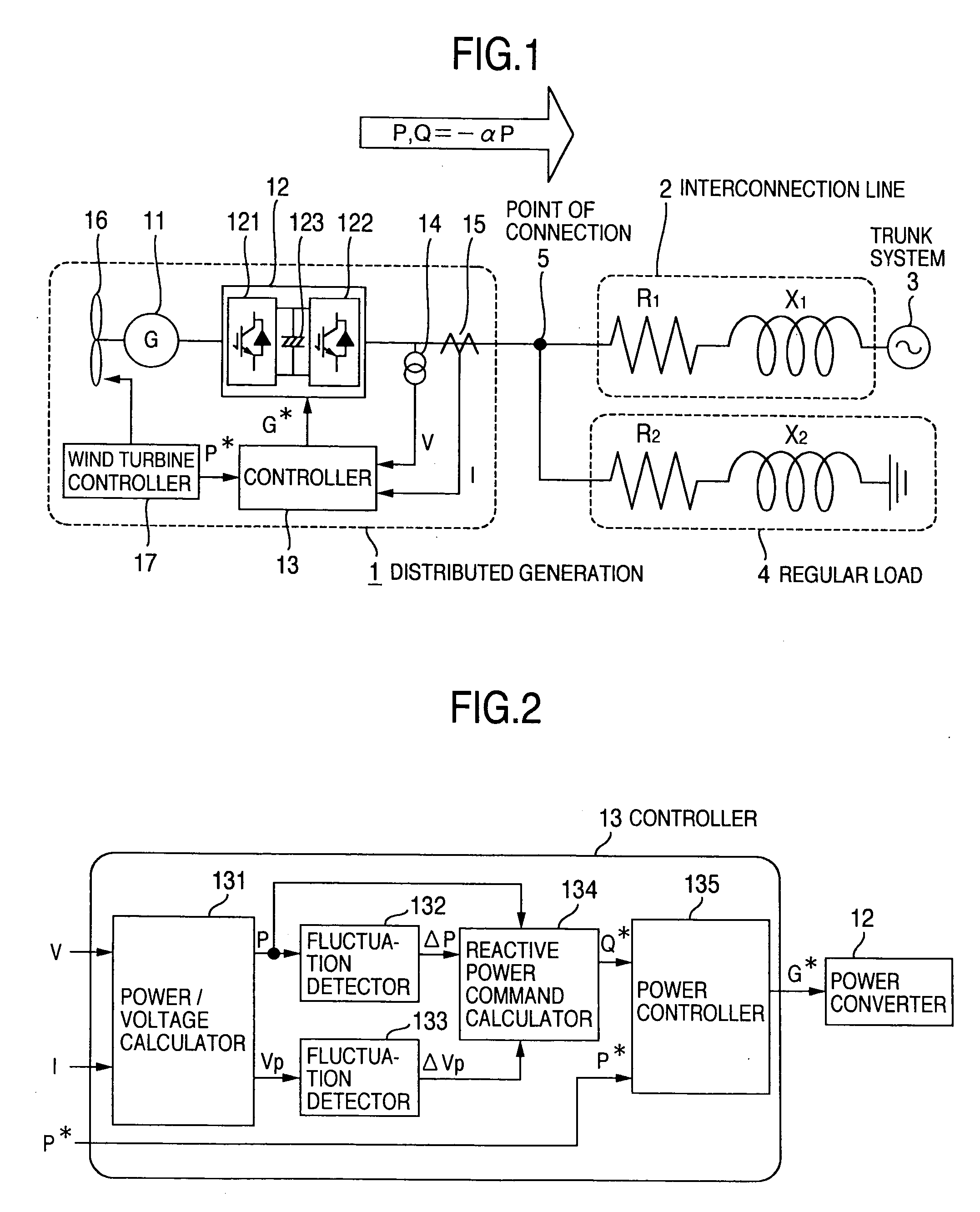Distributed generation system and power system stabilizing method
a technology of distribution generation system and power system, applied in the direction of electric generator control, dynamo-electric converter control, machines/engines, etc., can solve the problems of increasing loss, and affecting the stability of power distribution system
- Summary
- Abstract
- Description
- Claims
- Application Information
AI Technical Summary
Benefits of technology
Problems solved by technology
Method used
Image
Examples
embodiment 1
[0033]FIG. 1 schematically shows a block diagram of a distributed generation system provided with a power system stabilizer, as a first embodiment of this invention. A distributed generation 1 is connected via a system interconnection line or cable 2 with a trunk system 3. Let the resistance and the reactance of the impedance of the distribution feeder 2 be represented by R1 and X1, respectively. At the point 5 of interconnection between the distributed generation 1 and the interconnection line 2, or at any point on the interconnection line is connected a regular load 4 such as any of domestic electric appliances or factory machinery which consumes electric power. Similarly, the regular load consists of its resistance R2 and reactance X2.
[0034] In this embodiment, a wind turbine generator system serves as the distributed generator 1. The distributed generator 1 comprises a power generator 11, a power converter 12, a controller 13, a voltage detector 14 and a current detector 15. Th...
embodiment 2
[0064]FIG. 10 schematically shows the structure of a reactive power command calculator 134a which includes the calculation of a parameter α(t) for a distributed generation system provided with a power system stabilizing apparatus according to the second embodiment of this invention. FIG. 10 is used here in place of FIG. 6. This second embodiment differs from the first embodiment in the manner that the reactive power command Q* is generated.
[0065] The voltage amplitude Vp at the point 5 of connection fluctuates in response to the fluctuation ΔP of the active power P generated by the distributed generation 1. Apparatuses belonging to the power system, such as SVRs (series voltage regulators), transformers, power generators, SVCs (static var compensators), etc. can control the long period component of the voltage amplitude fluctuation in such a manner that the extent of that fluctuation may fall within a predetermined range. In this case, therefore, the distributed generation has only...
embodiment 3
[0071]FIG. 11 schematically shows the structure of a reactive power command calculator 134b which includes the calculation of a parameter α(t) for a distributed generation system provided with a power system stabilizing apparatus, according to the third embodiment of this invention. FIG. 11 is used here in place of FIG. 6 or FIG. 10. This third embodiment differs from the first and second embodiments in the manner that the reactive power command Q* is generated.
[0072] To begin with, to obtain the parameter α(t), let a selector 1342 choose zero (0) as its output and the reactive power command calculator 134b issues a zero reactive power command, i.e. Q*=0. Under this condition, the distributed generation 1 starts operating with its output reactive power Q equal to 0. Now, the system voltage fluctuation ΔVp1 due to the active power fluctuation ΔP is fed to a rotational coordinate transformer 1343 shown in FIG. 11 so as to be subjected to coordinate transformation. Coordinate transfor...
PUM
 Login to View More
Login to View More Abstract
Description
Claims
Application Information
 Login to View More
Login to View More - R&D
- Intellectual Property
- Life Sciences
- Materials
- Tech Scout
- Unparalleled Data Quality
- Higher Quality Content
- 60% Fewer Hallucinations
Browse by: Latest US Patents, China's latest patents, Technical Efficacy Thesaurus, Application Domain, Technology Topic, Popular Technical Reports.
© 2025 PatSnap. All rights reserved.Legal|Privacy policy|Modern Slavery Act Transparency Statement|Sitemap|About US| Contact US: help@patsnap.com



